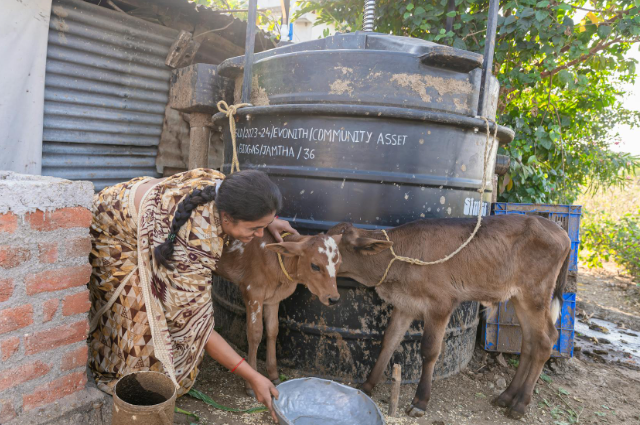
Gujarat, widely celebrated for its dairy industry, is now making strides in renewable energy by converting cattle waste into biogas. Through the Swachh Bharat Mission-Gramin initiative, led by the Government of India, the state has set up more than 7,400 biogas plants in just two years, thanks to the Gobardhan scheme.
Government Support Fuels Biogas Adoption
The success of this initiative can be attributed to the collaborative efforts between Gujarat’s state government and the central government’s supportive policies. The biogas plants not only manage waste efficiently but also serve as an alternative to conventional cooking fuels. This shift from firewood to biogas has significantly reduced indoor air pollution and respiratory ailments in rural areas such as Mandli village in Limkheda Tehsil, Dahod district.
Health and Economic Benefits for Rural Communities
Residents like Pushpa Patel have seen substantial results from this transition. She highlights how the biogas plant has relieved her family from the burdensome task of collecting firewood and the recurring expense of purchasing gas cylinders which cost around 1,500 rupees every two months.
Agricultural Advantages of Biogas By-products
In addition to providing a cleaner cooking alternative, the biogas plants produce organic slurry, a by-product that serves as a nutrient-rich fertilizer. This has led to improved agricultural yields by reducing the dependency on chemical fertilizers. Pushpa Patel further emphasizes how this organic fertilizer has helped her family in farming by allowing them to create their own manure and thus promoting sustainable agriculture. Through initiatives like the Gobardhan scheme, Gujarat is showcasing a model where waste management, renewable energy, and agricultural productivity converge to uplift rural livelihoods.
Reducing Reliance on LPG and Fostering Sustainable Practices
In the village of Mandli, Dahod district, the introduction of biogas plants has brought about a significant transformation in the lives of its residents. Kiran Kumar Patel, the village head had highlighted the multifaceted benefits of these eco-friendly solutions.
Firstly, the reliance on costly LPG cylinders has been drastically reduced. By utilizing biogas produced from organic waste, households are saving considerably on their cooking fuel expenses. This financial relief is particularly impactful for low-income families.
Secondly, the generated slurry from the biogas plant serves as an excellent natural fertilizer by enriching the soil and promoting sustainable farming practices. This aligns perfectly with the village's focus on natural farming methods by further enhancing agricultural productivity.
Thirdly, the availability of clean cooking fuel has eliminated the need to collect firewood from forests, thereby reducing deforestation and preserving the environment.
Government Support and Community Involvement
The government's substantial financial assistance has made biogas plant installations accessible to even the most economically disadvantaged households. Under the Swachh Bharat Mission-Gramin (SBM-Gramin) and Mahatma Gandhi National Rural Employment Guarantee Act (MGNREGA), the government covers a significant portion of the installation cost, bringing it down to a mere Rs 5,000 for the beneficiary. This minimal contribution not only makes the technology affordable but also fosters a sense of ownership and responsibility among the villagers.
Furthermore, the active participation of local self-help groups and NGOs has been instrumental in the successful implementation of this initiative. These organizations have played a crucial role in mobilizing communities, educating residents about the benefits of biogas plants and ensuring the smooth functioning of the scheme.
A Sustainable and Affordable Solution
The case of Mandli serves as a shining example of how government support, community involvement, and innovative technologies can empower rural households and promote sustainable living. By reducing reliance on fossil fuels, promoting natural farming, and protecting the environment, biogas plants offer a win-win solution for both individuals and the planet. This initiative not only improves the quality of life for rural communities but also contributes towards a greener and more sustainable future.
Empowering Villages with Biogas: Gujarat Success Story
A key component of the biogas plant initiative has been a strong focus on educating villagers. Through awareness campaigns and training programs, residents are taught how to effectively operate and maintain their biogas plants. This ensures the long-term sustainability and optimal functioning of these eco-friendly solutions.
Virabhai Dabhi, a consultant for the Swachh Bharat Mission-Gramin and District Rural Development Agency in Dahod, emphasized the importance of these educational efforts. He explained that the project aimed to install 200 biogas plants across nine villages in the Limkheda Tehsil. A crucial part of the initiative was to educate villagers about the significant cost savings associated with biogas plants. By using biogas for cooking instead of LPG, households could potentially save between Rs. 1000 and Rs. 1500 per month. Furthermore, the awareness campaigns highlighted the health risks associated with smoke inhalation from traditional cooking methods using firewood.
A Model for Sustainable Development
The successful implementation of biogas plants in Gujarat demonstrates the transformative power of integrated schemes and active community participation. By combining government support, community awareness, and hands-on training, this initiative has empowered rural households and fostered sustainable development practices.
The Gujarat model serves as an inspiration for other states seeking to adopt clean energy solutions and improve the quality of life for their rural populations. This approach not only aligns with the vision of a "Clean India" but also contributes significantly to global efforts towards sustainable development.
Key Takeaways:
- Education is crucial: Training programs and awareness campaigns empower villagers to effectively use and maintain biogas plants.
- Significant cost savings: Biogas plants offer substantial financial benefits by reducing reliance on expensive LPG cylinders.
- Improved health and well-being: By eliminating the need for firewood, biogas plants reduce smoke inhalation and improve the health of villagers.
- A sustainable future: The Gujarat model demonstrates the potential of integrated schemes and community involvement in promoting sustainable development.
Gujarat’s experience with biogas plants serves as a powerful example of how local innovation, when supported by effective policies and community engagement can lead to significant environmental and social benefits. It stands as a blueprint for sustainable development that other states and even countries can learn from, contributing to a cleaner, greener planet for future generations.
. . .
References:
